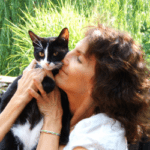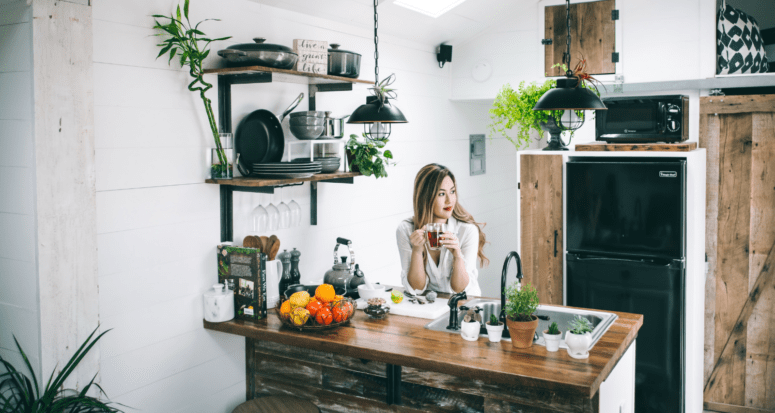Design the Perfect Little Kitchenette with These Designer-Approved Tips
- Published on
- 7 min read
-
 Lori Lovely Contributing AuthorClose
Lori Lovely Contributing AuthorClose Lori Lovely Contributing Author
Lori Lovely Contributing AuthorLori Lovely edited the Real Estate Home section for the Indianapolis Star and covered the annual Dream Home construction and decor for Indianapolis Monthly magazine. She has written guides for selling houses and more.
A kitchenette is just a “simplified kitchen paired down to the essentials,” shares MacKenzie Cain, interior designer for Chicago’s Habitar Design. Those essentials depend on the use of the space, but generally include a small refrigerator, microwave, sink, stovetop, countertop, and cabinetry. “If it is not the main source of someone’s daily kitchen needs, it might only feature a fridge and microwave. If this is an in-law suite, it would include more features,” Cain adds.
Still, despite its miniature nature, a kitchenette is an important part of the guest quarters, just as the kitchen is the heart of a home. That’s why we’ve rounded up these 14 tips to help you create the perfect kitchenette and make the most of your (tiny) space.

1. Limit your appliance selection
Most kitchenettes aren’t large enough to house as many appliances as a regular-sized kitchen. Depending on how you intend to use the room, you may just want to include a microwave oven, a mini-refrigerator, and a sink. But if you want guests to have the ability to cook as they would in a full kitchen, you’ll need to do some extra planning.
Measure the kitchenette space and research narrow appliance models that will fit without compromising too much counter space. Here are some tips to help you choose the essential appliances. You should skip non-essentials like trash compactors and dishwashers, by the way.
Select a mini or narrow refrigerator
“The most important would be the refrigerator,” Cain says. All of the appliances selected should be a smaller or narrower size to maximize space and function in the kitchenette.
Look for compact refrigerators or mini-fridges that are only 19 inches wide compared to a standard-size refrigerator’s 28-inch to 39-inch width. One popular model is the Liebherr UIK 1550.
Opt for a two-burner stove
A two-burner stove should suffice for most meals and will save space. Just understand that slimmer doesn’t necessarily mean less expensive. Don’t forget to install a sleek range hood just above it.
Alternatively, you can choose a dual-purpose convection microwave that combines the functions of a microwave and convection oven in one small package. You can bake and roast food in a convection oven, making it a good option for small spaces.
2. Add a narrow sink with a floating dish rack on top
Even if you skip the stove, don’t scrap the sink. A small sink that’s just 9 inches deep by 15 inches wide will do. This Fyndig sink, which is 15 inches by 13 inches, is an affordable option. Even if your kitchenette can fit a larger sink, it’s probably not worth losing limited countertop space over.
For even more functionality, consider purchasing a sink with a wood-cutting board cover. Choose a drying rack that sits over the sink to save even more space.
3. Choose a coffee maker that tucks away
Most of the world drinks coffee, so whether you have the occasional overnight guest or a long-term resident, you’ll probably want to provide them with a coffee maker. Slim it down with a single-serve machine that easily tucks into a cabinet when not in use.

4. House small appliances in an appliance garage
If you can’t let your guests live without small appliances, add an appliance garage to store items like the coffee maker, toaster, and blender. This cabinet features doors that fold up and down like a garage door so you can easily access plugged-in appliances and hide them just as easily when you finish using them.
5. Keep countertops clear with a magnetic knife rack
In a small kitchenette, every inch of drawer and countertop space is precious. Instead of storing knives in a drawer or knife block, mount them on the wall with a magnetic knife bar. You can efficiently store other small cooking utensils here too!
6. Store pots and pans overhead with a hanging pot rack
To continue with the vertical storage theme, install a hanging pot rack to organize pots and pans. A simple oval pot rack with 12 hooks should be large enough, but a smaller, wall-mounted rack may better suit more petite spaces.
If you care more about your kitchenette’s appearance than functionality, consider skipping the pot rack for a less visually cluttered space.

7. Add a rolling island for a versatile workspace
You might assume that a kitchenette is too small to include an island. However, a proportionally sized kitchen island can add additional counter space, storage, and seating to your kitchenette. A rolling island is a great option for small spaces since you can easily move it aside if needed.
“Adding a rolling island will likely double your workspace,” Cain adds. For maximum space savings, choose a fold-up rolling island that collapses and tucks away into narrow storage spaces.
8. Combine open shelving and closed cabinets
The debate rages on: upper cabinets or open shelving. “This really depends on the space itself,” Cain notes. While shelves contribute to an open feeling that can make a space feel larger, she suggests including some closed cabinetry for general pantry storage. This way, you don’t need to keep your kitchenware perfectly organized for the room to look neat.
Whichever route you choose, add extra storage by installing hooks for coffee mugs under the overhead unit. “Every inch of space is important and should be utilized,” Cain admonishes. Knife racks, spice racks, hooks for mugs, shelving for plates — all of it helps.
“You definitely want to look at all open areas for storage potential to maximize space.”
9. Chose durable countertops
No matter how slight your scullery may be, you’ll need a decent amount of workspace, counter space. If you go for more traditional countertops, choose quartz, granite, or butcher block. “All are durable and will hold up nicely over time,” Cain says.
Here’s a quick comparison of the most popular countertop materials:
- Granite: While that may be true, granite requires more work than quartz. Because granite, a natural stone, is porous, it can stain if you don’t seal it periodically.
- Butcher block: Butcher block is a countertop material made of wood. Like granite, it requires periodic sealing and is subject to water damage if left untreated.
- Quartz: Quartz, engineered from ground natural stone and resin, is non-porous and easy to maintain. Because it’s an engineered material, quartz doesn’t chip or crack as easily as granite. It’s available in a wide range of colors, usually with more uniformity in the pattern, making a modest kitchenette feel larger.
- Laminate: Laminate consists of layers of plastic bonded to particleboard. It’s the least expensive option in this list. However, laminate is not as durable as the other materials — it’s susceptible to delamination and scratching.
10. Create more prep space with pull-out and fold-up boards
For even more countertop space, take advantage of custom cabinetry options. You can extend your counter by adding a fold-up extension to the end. Pull-out cutting boards are another great way to increase your workspace.

11. Opt for a light, reflective backsplash
Some homeowners use the countertop material as a backsplash for a continuous look, Cain explains. But the National Kitchen and Bath Association advises that solid surface backsplashes have been “superseded by glass, granite, natural stone, and tile” as buyers’ top choice.
In a kitchenette, it’s more important than ever for a backsplash to bounce light back into the room to make it look more spacious. Reflective backsplash options include white ceramic subway tile, light stone tile, polished porcelain tile, and glass tile.
Glass tile is particularly versatile. Available in a variety of colors, patterns, and sizes, these tiles can either “pop” or add a sophisticated, subtle accent. Bonus: because glass is less porous than ceramic tiles, glass tiles are more resistant to stains, mold, and mildew. Drawbacks include vulnerability to scratching and a higher cost.
If you’re bold, try the ultimate in reflectivity: a mirrored backsplash. This ’80s trend is on the rise, adding bling, brightness, and depth to a room. Just note that this backsplash is very high-maintenance: it’s subject to scratching and breaking, shows every water drop, and may rot on the edges if water seeps in.
12. Brighten the room with a balanced lighting scheme
You can’t count on a backsplash to provide all the light in the joint. You’ll need lighting in layers: overhead, task, and under-cabinet. “Having multiple levels of light is important,” Cain notes.
Start with ample overhead lighting
If you include a kitchen island, install a glass pendant light above it to add style and workspace lighting. If you’re worried your space is too small for hanging lighting, consider adding shorter flush-mounted lights instead. Track lighting is another great option, though it may not light the room as evenly.
Once you hone in on the lighting fixture style, determine what type of light bulbs will be most flattering in your space:
- Incandescent lights produce a warm, yellow light, ideal for downlights and recessed light.
- Halogen lights provide a crisp white light that’s excellent as task lighting.
- Fluorescent lights come in shades from warm to cool. Fluorescents are also highly energy-efficient.
- LEDs offer the most energy efficiency.
- Xenon lights aren’t as energy-efficient but rank better than incandescents and give off a warm glow.
Add versatility with dimmable under cabinet lights
Lights under the cabinets can add to the overall brightness and ambiance of a kitchenette by eliminating shadows. This lighting also functions as task lighting for prep work and cooking.
13. Paint the walls and cabinets light shades
“Keep the colors light and airy,” Cain advises. “That will make [the kitchenette] feel bigger.”
For maximum brightness, paint your kitchenette white. White walls make the room appear bigger, plus match any decor. Save time with Behr’s primer and paint in one or choose a Benjamin Moore shade of white that doesn’t yellow.

14. Make a statement with personalized design choices
Just because a kitchenette is small doesn’t mean it can’t have a big personality. Add some finishing touches to make your kitchenette your own.
Change the hardware on your drawers and cabinets. It’s one of the easiest, most affordable ways to add a flavor to the kitchenette without taking up any additional space. Choose sleek, brushed or satin brass hardware for an on-trend look. For a more timeless look, stainless steel or matte black is the way to go. You can even mix metals … carefully.
Style the kitchenette with abstract wall art and colorful seating. Funky bar stools or luxurious dining chairs can completely change the vibe of the room.
“Bring in different materials and textures,” Cain suggests. “This will keep the kitchenette looking more thought-out and interesting.”
Just remember to edit so your kitchenette doesn’t become cluttered with so much “personality” that there’s no room left to cook.
Header Image Source: (Tina Dawson / Unsplash)
